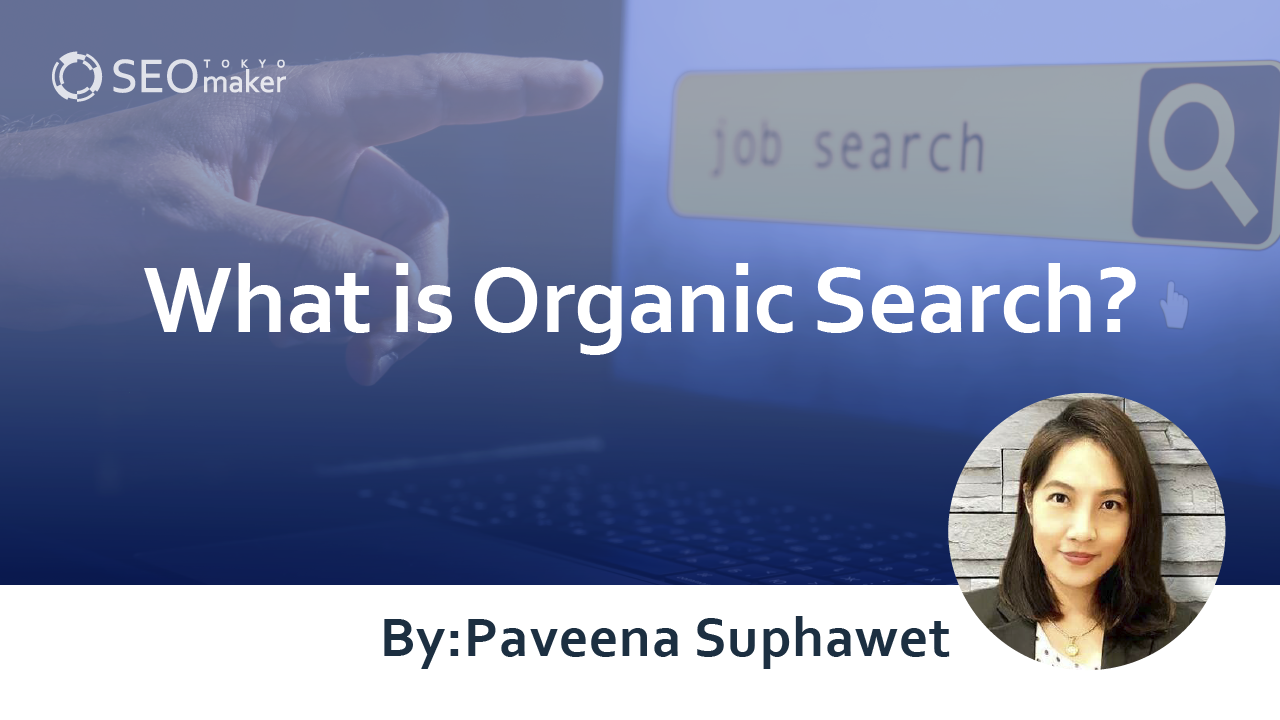What is Organic Search? : Explaining the Difference from Paid Search (Ads)
contents
- 1 What is Organic Search?
- 2 What is Paid Search (Listing Ads)?
- 3 Summary

In recent years, the digitalization of sales has led to an increase in companies focusing on attracting customers through the web.
To attract customers, increasing traffic to a website is essential. However, many site managers struggle with how to boost their site’s traffic.
One effective method to increase traffic to your website is through ‘organic search.’
Organic search refers to the search results that appear naturally, excluding paid listings and advertisements, in response to keyword searches.
By ranking high in organic search results, you can increase traffic, generate more leads, boost sales, and enhance your branding efforts.
Achieving high rankings in organic search results requires aiming for greater visibility. This involves implementing SEO strategies and building a site with a ‘user-first’ approach.
This article explains the basics of organic search and provides simple methods for increasing traffic through organic search.
What is Organic Search?
Organic search (also known as natural search) is one of the primary sources of traffic for inbound marketers. It refers to the search results that appear in response to keyword searches, excluding the ads at the top.
In the diagram above, the ‘SEO’ section represents the organic search results.
Generally, being ranked ‘first’ in organic search results is said to achieve a click-through rate (CTR) of about 30%. Once you acquire traffic from organic search, you can expect continuous site visits.
The click-through rates and search result rankings on Google are as follows.
Google Search Ranking and Click-Through Rates (2020) Reference: SISTRIX
|
Search Rank |
Click-Through Rate |
|
1st |
28.5% |
|
2nd |
15.7% |
|
3rd |
11.0% |
|
4th |
8.0% |
|
5th |
7.2% |
|
6th |
5.1% |
|
7th |
4.0% |
|
8th |
3.2% |
|
9th |
2.8% |
|
10th |
2.5% |
This chart shows that the higher the ranking, the more traffic the site receives. Increased site traffic and visitors can lead to easier customer acquisition and revenue growth.
For more information on traffic, please refer to the article ‘What is Traffic? Explaining the Types and How to Increase It. ‘
What is Paid Search (Listing Ads)?
Paid search, or listing ads, are advertisements that appear in search engine results in response to user searches for specific keywords.
Also known as ‘search-linked ads,’ they incur costs each time a user clicks on the link. Examples include Google Ads and Yahoo! Ads.
Paid search allows advertisers to customize their ad delivery settings based on their objectives and target audience, displaying highly relevant ads that can achieve significant results.
However, the downside is that it cannot reach users who do not search for the advertised keywords, and it requires ongoing costs (operating costs and labor costs). For scenarios where immediate results are not necessary, higher ranking in organic search is more effective for customer acquisition.
For more details on listing ads, please refer to the article ‘The Difference Between SEO and Listing Ads: How to Maximize Customer Acquisition . ‘
Difference Between Organic Search and Paid Search (Listing Ads)
The differences between organic search and paid search (listing ads) can be summarized in the following three points.
|
Ads |
Organic Search |
|
|
1. Display Position |
Top |
Bottom (Under Ads) |
|
2. Cost |
Charged per click |
Basically free |
|
3. Display Ranking |
Determined by ad rank |
Search engine algorithm |
Display Position
As shown in the photo below, paid search results (ads) are displayed at the top, and organic search results are displayed below them. In addition, for ads, the word ‘Ad’ is displayed to the left of the title to indicate to users that it is an advertisement.
Cost
As the name ‘paid search’ implies, listing ads incur costs, while organic search can be cost-effective depending on the site manager’s efforts.
In the case of listing ads, costs are calculated by multiplying the click cost by the number of clicks. If there is a lot of competition for the advertised keyword, the click cost can increase. The approximate click cost can be checked using tools like ‘Google Keyword Planner.’
For Google listing ads, you can set a minimum cost of 1,000 yen, so you can keep costs down if you are targeting keywords with low search volume or if you are a freelancer wanting to place ads.
However, if you outsource to an advertising agency, be aware that many companies set a minimum ad spending amount or charge a commission.
On the other hand, with organic search, you can increase your ranking by continuously implementing SEO strategies. If you have SEO knowledge and can handle it in-house, there are no costs. Once ranked high, there are no costs regardless of the number of clicks, which is a significant advantage.
When outsourcing SEO strategies, the costs may vary depending on the service, but generally, the costs are as follows.
- SEO Consulting: 100,000 to 300,000 yen
- Content SEO: 30,000 to 100,000 yen
- On-Page SEO: 100,000 to 1,000,000 yen
- Off-Page SEO: 20,000 to 1,000,000 yen
For more information, please refer to the article: ‘SEO Costs and Consulting Fees: An Overview of SEO Pricing and How to Choose the Right Service.’
When outsourcing, it is important to select the most suitable service for your site’s condition to keep costs down.
Display Ranking
For ads, the display ranking is determined by an auction system based on ‘Ad Rank’ for Google Ads and ‘Auction Rank’ for Yahoo! Ads.
Ad Rank is a metric that considers the following factors, with higher ad rank ads appearing higher.
- Ad quality (estimated click-through rate, ad relevance, landing page experience, etc.)
- Bid amount
- Ad rank threshold
- Competition in the auction
- Context of the search (user location, device, search time, nature of search terms, other ads and search results on the page, and other user signals and attributes)
For example, the ad rank is determined as shown in the table below:
|
Advertiser |
Quality Score |
Bid Amount |
Ad Rank |
Display Position |
|
Company A |
2 |
300 yen |
300 yen × 2 = 600 |
2 |
|
Company B |
7 |
100 yen |
100 yen × 7 = 700 |
1 |
|
Company C |
1 |
500 yen |
500 yen × 1 = 500 |
3 |
To improve the display ranking of listing ads, it is necessary to increase the ad rank, which can be achieved by raising the bid amount or improving the quality score/quality index.
The appropriate bid amount can be checked using the [Estimated Bid (Top of Page Bid)] indicator. While it’s possible to achieve a higher ranking by setting a high bid amount, it may lead to poor cost-effectiveness and profit pressure. Therefore, the most effective method is to increase the quality score while keeping the bid amount low.
In the case of organic search, rankings are determined by the search engine algorithm. The followings are ranking factors.
- -Internal and external link structure
- -Backlink structure
- -Technical factors (URL length, load speed, etc.)
- -Content quality and structure
- -Media enhancements such as videos and images
- -Mobile optimization
- -https encryption (SSL)
Importance of Organic Search
The reason organic search is highlighted over social traffic and other types of traffic is due to its association with “user intent.”
Users who enter specific keywords into search engines are looking for something specific. Websites that can fulfill these search intents can convert these users into customers, subscribers, or regular visitors.
Therefore, once you acquire traffic from organic search, you can expect consistent access to your site, making it crucial for stable revenue generation.
However, maintaining top rankings in organic search has become increasingly challenging as Google frequently updates its unique algorithms.
For example, the “link removal” trend that followed Google’s Penguin update in April 2012 overturned previous SEO strategies.
Related article : What is Penguin update?
This underscores the need to adapt quickly to changes in Google’s algorithms and adjust SEO strategies accordingly.
How to Aim for Higher Rankings in Organic Search
The display of websites in organic search involves three main elements: crawling, indexing, and the search algorithm. Websites are displayed following these processes.
To ensure proper evaluation by Google, continuous efforts in the following areas are essential.
- On-page SEO
- Off-page SEO
- Content SEO
On-page SEO
On-page SEO refers to improving the site structure (overall design) to an optimal state. Specific measures include “crawl optimization,” “index optimization,” and “ranking optimization.” The goal is to create a site that is easy for both users and Google’s crawlers to understand.
Crawl Optimization
To ensure Google’s crawlers can navigate all pages on your site without issues, focus on the following points.
- Sitemap Submission
- Internal Linking
- robots.txt Configuration
- Breadcrumbs
- Directory Structure
- Pagination
- Redirects
Index Optimization
Content retrieved by Google crawlers is stored in a database known as the search index. However, if Google cannot understand the content of your site, it will not be properly indexed, meaning your site won’t appear in Google search results despite being published online. To prevent this, the following measures should be taken.
- Setting Titles and Descriptions
- Setting Header Tags
- Optimizing Images
- Setting Canonical Links
- Implementing Structured Data
Ranking Optimization
Google uses various factors to determine rankings, with a strong emphasis on user experience. Therefore, it’s important to optimize for mobile devices and improve page loading speed. Google employs over 200 automated algorithms to determine the search rankings of a vast number of sites.
For more details on on-page SEO, refer to the article on On-page SEO.
Off-page SEO
Off-page SEO involves obtaining links from other websites to your own, thereby driving traffic and improving your site’s credibility in the eyes of Google. The idea is that a high number of external links signals to Google that your site is popular and authoritative. However, it’s crucial to obtain “quality backlinks” from websites related to your niche.
In the past, some companies offered services to boost external links. However, Google now prohibits the purchase of links to increase external link quantity. Therefore, you need to create content that others want to link to organically. Effective strategies include publishing valuable content that others will share and linking to your site on social media. When leveraging social media, ensure that the content is designed to be easily shared by users.
For more information on external links, refer to the article on Off-page SEO and Backlink Acquisition.
Content SEO
Content SEO focuses on creating and optimizing blog articles to achieve higher search rankings and increase traffic. While producing valuable content regularly is effective for SEO, randomly creating content around keywords is unlikely to improve search rankings.
Instead, aim to create content that adheres to “E-A-T” principles—Expertise, Authoritativeness, and Trustworthiness.
Although E-A-T is a set of criteria defined by Google, it does not have a measurable score and is not included in the search algorithm. Therefore, it should be considered as an “element” to incorporate when creating high-quality content.
What is E-A-T?
E-A-T stands for Expertise, Authoritativeness, and Trustworthiness. Among these, “Expertise” is considered the most critical factor, as it evaluates how well the content is crafted based on specialized knowledge. To comprehensively enhance E-A-T, consider the following points
- Collaborate with Experts
- Clarify Content Purpose
- Back Up Claims
- Consider Multiple Perspectives
By clearly defining the purpose of the content and directly addressing the topic, you can enhance its expertise. When creating content outside your area of expertise, collaborating with an expert can help ensure the content remains thorough and accurate.
Additionally, to increase trustworthiness, it’s essential to consider the topic from multiple angles and examine how different perspectives affect the overall content. For example, when creating content about “types of diets,” consider the various search intents users might have, such as wanting to know methods to lose weight without eating, ways to lose weight while eating, ways to lose weight without exercising, and quick weight loss methods. Supporting the content with research data and scholarly articles can make it more credible.
In December 2022, another “E” for Experience was added, making it EEAT.
Key Points for Content Creation
When creating content, it’s crucial to understand the search intent behind the keywords and provide answers that users are looking for.
Setting up personas and creating customer journeys can help analyze why a persona needs the information related to a keyword. Tools like “Rakko Keyword” and “Google Keyword Planner” can also help analyze related keyword suggestions.
For more detailed information on Content SEO, please refer to the article on Content SEO.
Benefits of SEO for Organic Search
Implementing SEO for organic search allows you to aim for top rankings, which can lead to branding, increased traffic, and attracting users close to conversion. Therefore, a website that ranks well in organic search is a valuable marketing asset.
Benefits of SEO
- Aim for Top Rankings
- Attract High-Intent Customers
- Branding
- Increase Traffic
Users often search with specific problems in mind, looking for pages that can help solve their issues. If your site appears at the top of the search results, it is more likely to be clicked. Including relevant keywords in the site title and description further increases this likelihood.
Including your company name, product name, or service name in the title helps with branding, as users will see your brand frequently, enhancing recognition. In essence, SEO not only helps in attracting steady traffic but also supports branding efforts and boosts sales.
While SEO does not have clear-cut evaluation criteria and requires a medium-to-long-term commitment, it can lead to low-cost traffic growth once effective. Stopping SEO efforts prematurely will waste previous efforts, so perseverance is key.
For further reading, refer to the recommended article: Complete Guide to SEO in 2022: Basics and Strategies for Beginners.
Reasons for Decline in Organic Search Traffic and Solutions
Despite implementing SEO strategies, there can be occasions where organic search traffic decreases. This could be due to factors such as Google’s algorithm updates or penalties, which may result in index removal or lowered rankings from Google.
Other factors may also be involved, and randomly addressing issues will not lead to improvement.
When you notice a decrease in organic search traffic, it’s essential to identify the cause. Investigate the following points and analyze “when the decrease occurred,” “where the decrease occurred,” and “whether there were any internal or external changes.
- Search volume
- Number of search impressions
- Search rankings
- Click-through rate (CTR)
- Frequency of search engine crawling
- Potential penalties from search engines
Based on this analysis, it’s necessary to take appropriate actions such as rewriting articles, adding new content, and reinforcing internal SEO measures to address the causes of the decline swiftly.
- Another strategy is to explore methods to gain traffic outside of organic search. This can include using listing ads, sending newsletters, and leveraging social media platforms such as Instagram, Twitter, and Facebook to gain followers. By sharing valuable information with links, you can encourage followers to click on the links and visit your site.
Tools for Analyzing Organic Search Traffic
Two essential tools for analyzing organic search traffic are as follows.
- Google Analytics
- Google Search Console
Google Analytics
Google Analytics can be used to analyze website traffic.
The method is to log in to your Google Analytics account, select “Acquisition” > “All Traffic” > “Channels” from the menu, and you will see basic information about traffic sources. Additionally, click “Acquisition Report” in the bottom right corner of the graph to further investigate this data.
Google Analytics categorizes traffic sources as follows.
- Direct: Traffic with unknown sources or referrers.
- Email: Traffic from email marketing that is properly tagged with email parameters.
- Organic Search: Traffic from search engine results.
- Paid Search: Traffic from paid advertisements through platforms like Google AdWords or other paid search platforms.
- Display: Traffic from display ads, such as image banners.
- Referral: Traffic occurring when users find the website from non-major search engines or sites (eg, personal blogs).
- Social: Traffic from social networks such as Facebook, LinkedIn, Twitter, and Instagram.
- Other: Traffic from other sources.
By using these tools and methods, you can better understand the reasons for traffic changes and take appropriate actions to mitigate declines and enhance overall site performance.
Google Search Console
Google Search Console allows you to check the performance of your website on Google search results for the keywords that currently drive traffic to your site. You can review metrics such as clicks, impressions, click-through rate (CTR), and average position within a specified period.
Due to current cookie regulations, analytics tools like Google Analytics cannot obtain data on the specific keywords used in searches. This data is only available through Google Search Console.
How to Use Google Search Console
From the menu, navigate to “Performance” > “Queries” to see the keywords your website is appearing for in Google search results. This allows you to check if your site is appearing for your targeted keywords.
Summary
In this article, we discussed organic search. Organic search refers to the non-paid results in search engine listings. By capturing organic traffic, you can ensure a continuous stream of visitors to your site, which contributes to increased sales. To boost this traffic, it’s essential to improve your site’s ranking through SEO strategies. If your company lacks the necessary SEO knowledge, consider outsourcing to a professional. When choosing an SEO agency, it’s crucial to look for technical expertise, proven results, and a willingness to provide personalized consultation.










![What is a Description? Explaining the Meaning, Writing Style, and Changing Word Count – [2023 Edition]](https://www.switchitmaker2.com/en/wp-content/uploads/2024/09/what-is-description.webp)










